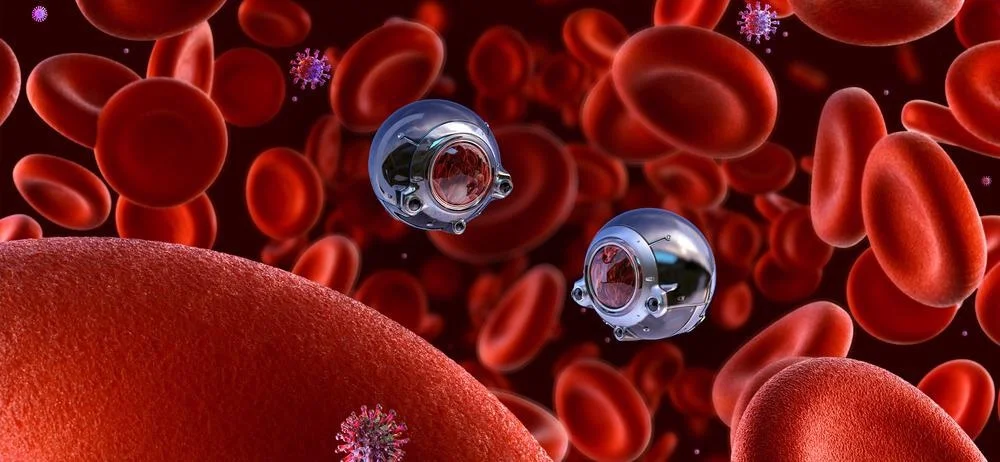The Future of Healthcare: How AI-Powered Nanobots Could Change Everything

a fleet of microscopic robots, so small they can travel through your bloodstream, working around the clock to keep you healthy. They could deliver medicine directly to sick cells, clear dangerous blood clots, or even detect early signs of disease before any symptoms appear. This isn’t a scene from a sci-fi movie . it’s the future of medicine, powered by AI-driven nanobots.
HOW THEY WORK ?
Target Detection
Nanobots detect diseases by navigating through the body and analyzing biological signals at a microscopic level. These tiny robots are often engineered with special sensors and AI algorithms that help them identify unusual changes in cells, tissues, or bodily fluids. Here’s how it works step by step:
- Sensing Biomarkers
Nanobots are equipped with chemical or biological sensors that detect biomarkers—tiny molecules or proteins that indicate the presence of a disease. For example, cancer cells release specific proteins that healthy cells don’t. Nanobots can “sniff out” these signals at a molecular level, long before a traditional scan or blood test would detect them. - AI-Driven Pattern Recognition
Artificial intelligence gives nanobots the ability to analyze massive amounts of biological data in real time. By comparing what they find inside your body with known patterns of healthy vs. diseased cells, they can identify abnormalities quickly and accurately. - Real-Time Imaging & Mapping
Some nanobots are designed to send back imaging data, creating a detailed “map” of your body at the cellular level. This allows doctors to see where a disease is forming and how far it has spread. - Cellular Interaction
Advanced nanobots can even attach to cells, scan their surfaces, and check for structural abnormalities, genetic mutations, or chemical imbalances—all of which provide early clues about disease. - Continuous Monitoring
Unlike one-time tests, nanobots can stay in the body and provide real-time health updates. They can track disease progression, monitor treatment effectiveness, and alert doctors if something changes suddenly.
Example in Practice:
- For cancer detection, nanobots could identify tumor-specific biomarkers in blood or tissues far earlier than imaging machines can.
- In cardiovascular diseases, they can sense plaque buildup or detect microscopic clots before they become life-threatening.
Treatment of disease
How Nanobots Treat Diseases
Nanobots don’t just detect illnesses—they’re designed to directly treat problems at the cellular level with incredible precision. Here’s how they work in treatment:
- Targeted Drug Delivery
- Instead of flooding the whole body with medicine (like chemotherapy or antibiotics), nanobots carry drugs directly to the diseased cells.
- This means fewer side effects and a much higher dose of medicine where it’s needed most.
- Example: A nanobot could deliver chemotherapy straight to a tumor while leaving healthy cells untouched.
- Breaking Down Blockages
- In heart disease, nanobots can travel through blood vessels to dissolve blood clots or plaque buildup.
- This could prevent heart attacks or strokes without major surgery.
- Cell and Tissue Repair
- Some nanobots are being designed to repair damaged tissues at a microscopic level.
- Example: Healing tiny tears in blood vessels or regenerating damaged nerve cells.
- Destroying Harmful Cells
- Nanobots can be programmed to identify and destroy harmful cells like cancer cells or bacteria.
- They might use heat, chemical reactions, or mechanical movement to kill or neutralize these cells without harming surrounding tissue.
- Cleaning Up Toxins
- Future nanobots could act like microscopic cleaners, removing toxins, cholesterol deposits, or harmful proteins from the bloodstream to keep your body healthier.
- Precision Surgery Without Cuts
- Instead of traditional invasive surgery, nanobots could perform “nano-surgery” inside your body, fixing problems without large incisions or scars.
The Big Advantage:
Nanobot treatments are highly personalized, meaning they can adapt to each patient’s unique biology, making medicine safer, faster, and far more effective.
Future of AI Nanobots
The future of medicine may not lie in bigger hospitals or more powerful machines, but in tiny robots no larger than a cell. AI-powered nanobots are emerging as one of the most exciting areas in healthcare. They have the potential to detect, treat, and even prevent diseases in ways that seem like science fiction today.
Smarter Disease Detection
In the near future, nanobots could act as 24/7 health guardians inside your body. With advanced sensors and AI algorithms, they could constantly scan your blood for early signs of illness. This means spotting cancer cells, infections, or harmful proteins long before symptoms show. Early intervention could become routine, saving millions of lives each year.
Ultra-Precise Treatments
AI-driven nanobots will change how medicine is delivered. Instead of using treatments that affect the entire body, nanobots will transport drugs directly to problem areas. Picture a cancer patient receiving chemotherapy that only targets tumors, or a heart patient whose nanobots dissolve blood clots without risky surgery.
Micro-Surgeries Without Scars
Future nanobots could perform microscopic surgeries inside your body without any incisions. These bots might repair tissues, unclog arteries, or remove harmful deposits in real time. This could turn once-dangerous surgeries into simple outpatient procedures.
Real-Time Health Monitoring
AI integration will let nanobots monitor your health constantly. Instead of waiting for annual checkups, your doctor could receive live data about your blood sugar, cholesterol, or even genetic changes. This would offer proactive care tailored to your specific needs.
Personalized Medicine for Everyone
As nanobots develop, treatments will become fully personalized. AI will analyze your genetics, lifestyle, and health history to create a custom medical plan. Nanobots won’t just treat disease; they’ll help prevent it, keeping you healthier for longer.
Challenges Ahead
Of course, this future won’t happen overnight. Scientists still face significant challenges, like ensuring nanobots are completely safe, finding ways to mass-produce them, and establishing global regulations for their use. Ethical issues such as data privacy and control over AI systems in the human body will also require careful attention.
A Glimpse of What’s Next
Despite these challenges, the potential is clear. In the next 10 to 20 years, AI-powered nanobots could shift medicine from reactive to deeply proactive, treating diseases before they cause harm and making healthcare truly personalized. These tiny machines might become as common as vaccines, leading to a future where technology and biology work together seamlessly to extend life and improve health.
The future of nanobots with AI isn’t just about small robots; it’s about redefining healthcare as we know it. It will make care smarter, faster, and much more human.

